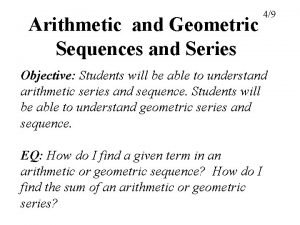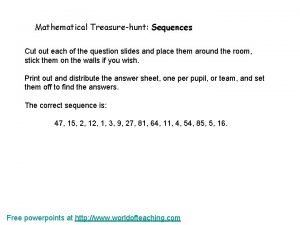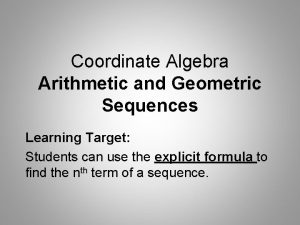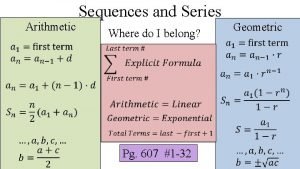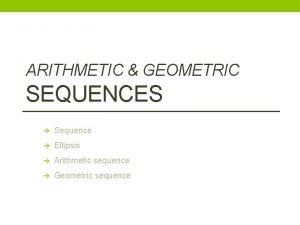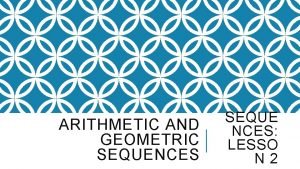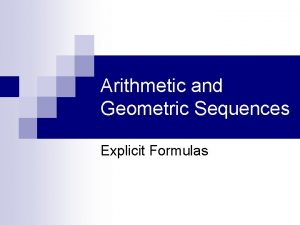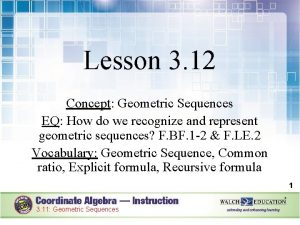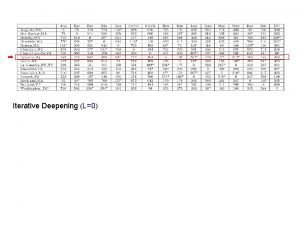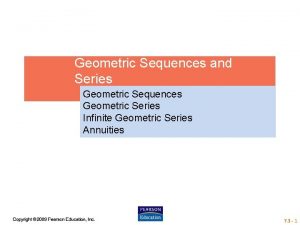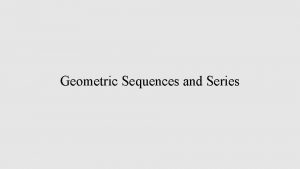Iterative Patterns Arithmetic and Geometric Define Iterative Patterns










- Slides: 10

Iterative Patterns Arithmetic and Geometric

Define Iterative Patterns… � Iterative Patterns follow a specific RULE. � Examples of Iterative Patterns: › › 2, 4, 6, 8, 10, … 2, 4, 8, 16, 32, … Rule: add 2 96, 92, 88, 84, 80, … Rule: multiply by 2 Rule: subtract 4 625, 125, 5, … Rule: multiply by 1/5

Arithmetic Sequence � Is an Iterative Pattern where the rule is to ADD or SUBTRACT to get the next term. � We call the number that you ADD or SUBTRACT the COMMON DIFFERENCE. � Examples of Arithmetic Sequences: d=3 › 3, 6, 9, 12, 15… › 85, 90, 95, 100, 105, … d = 5 › 5, 3, 1, -3, -5, … d = -2

Determine if the sequence is Arithmetic. If so, find the common difference. 1. 4, 6, 8, 10, 12, … 1. Yes. d = 2 2. 14, 12, 11, 9, 8, … 2. No 3. 2/ 3. Yes, d = 1/9 2/ , 3/ , 4/ , 5/ , 6/ , … 9 9 9 4. 99, 92, 85, 78, 71, … 5. ½, ¼, 1/8, 1/16, 1/32, … 5. No 6. 9, 6, 3, 0, -3, … 6. Yes. d = -3 9, 1/ 3, 4/ 9, 5/ 9, 2/ 3, … 4. Yes. d =-7

Write the first 5 terms of the Arithmetic Sequence. � a 1 = 2, d = 1 � a 1 = 2 means that the first term in your sequence is 2. � d = 1 means the common difference is 1. › Since “ 1” is positive, you will add “ 1” each time to get to the next term in the sequence. � The first 5 terms of the sequence are: › 2, 3, 4, 5, 6

Write the first 5 terms of the Arithmetic Sequence. 1. a 1 = 3, d = 7 1. 3, 10, 17, 24, 31 2. a 1 = 0, d = 0. 25 2. 0, 0. 25, 0. 75, 1 3. 4. a 1 = 100, d = -5 a 3 = 6, d = -4 3. 100, 95, 90, 85, 80 4. 14, 10, 6, 2, -2

Geometric Sequences � Is an Iterative Pattern where the rule is to MULTIPLY to get the next term. � We call the number that you multiply the COMMON RATIO � Examples of Geometric Sequences: › 4, 8, 16, 32, 64, 128, … Rule: r = 2 › 1000, 10, 1, 0. 1, … Rule: r = 1/10 › 81, 27, 9, 3, … Rule: r = 1/3

Determine if the sequence is Geometric. If so, find the common ratio. 1. -4, -2, 0, 2, 4, … 1. No 2. 2, 6, 18, 54, 162, … 2. Yes. r = 3 3. 2/ 3. Yes. r = -1 4. 1, 1. 5, 2. 25, 3. 375, … 5. 3/ 6. -2, -4, -8, -16, … 2/ , - 2/ , … , 3 3 3/ , ¾, 3/ , … , 16 8 2 4. Yes. r = 1. 5 5. Yes. r = 2 3/ , 6/ , 12/ , 24/ 16 16 6. Yes. r = 2

Write the first 3 terms of the Geometric Sequence a 1 = 24, r = ½ � a 1 = 24 means that the first term in your sequence is 24. � r = ½ means that the common ratio is ½. � › � You will multiply each term by ½ in order to get the next term in the sequence. The first 3 terms of the sequence are: › 24, 12, 6

Write the first 3 terms of the Geometric Sequence. 1. a 1 = 4, r = 2 1. 4, 8, 16 2. 1/ 2. 6, 2, 2/3 3. a 1 = 6, r = a 1 = 12, r = 3 - 1/ 3. 12, -6, 3 2
 Geometric sequences
Geometric sequences Arithmetic and geometric sequences and series
Arithmetic and geometric sequences and series Geometric iterative deepening search
Geometric iterative deepening search Arithmetic sequence scavenger hunt
Arithmetic sequence scavenger hunt Algebra sequence formula
Algebra sequence formula Geometric series formula
Geometric series formula Arithmetic vs geometric
Arithmetic vs geometric Geometric sequence function
Geometric sequence function Finite geometric series
Finite geometric series Arithmetic and geometric formulas
Arithmetic and geometric formulas Lesson 3: arithmetic and geometric sequences
Lesson 3: arithmetic and geometric sequences

